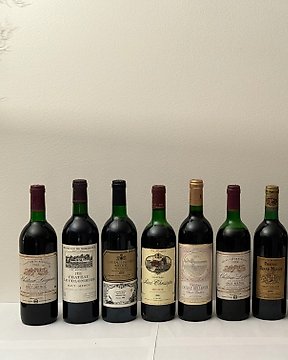
1988 x 2 Château le Colombier, 1986 x 2 Château Lieujean 1983 Château Grand Moulin, Château Hourbanon - Bordeaux 1988 Château Hauterive, 1986 Château Saint-Christophe, 1984 Château Laujac 1987 Château de la Croix, - 12 Pullot (0.7 L)
Nro. 83545837

Nro. 83545837

Saint-Émilion Grand Cru wines are produced under slightly tighter production restrictions than regular Saint-Émilion wines. As with other grand cru appellations, the intention behind this is to improve the quality, and to distinguish the area's finer wines from the more everyday wines.
This is not quite as straightforward in Saint-Émilion as it is elsewhere, however.
Grand Cru vs Grand Cru Classé
The designation Saint-Émilion Grand Cru is distinct from that of Saint-Émilion Grand Cru Classé. Confusingly for the uninitiated, the top-tier wines from Saint-Émilion are not marked out by their grand cru status, but by their appearance in the Saint-Émilion Wine Classification, which confers grand cru classé (64 Châteaux in 2012) and premier grand cru classé status (14 classés "B" and, at the very top, 4 classés "A").
This works in a similar way to the classifications of the Médoc, Graves and Sauternes, but with one significant difference: it is periodically reviewed to keep it up-to-date and relevant. It was first drawn up in 1955, and (after a controversial review in 2006) was most recently updated in 2012.
Grand cru regulations
There are four key production differences between the production restrictions for standard Saint-Émilion wines, and those classified as Grand Cru wines:
First, the vineyard yield is restricted to 8000 kilograms per hectare rather than 9000 (which roughly translates to 5500 liters per hectare rather than 6500).
Second, the grapes (with the significant exception of regional workhorse Merlot) must be harvested with a must weight of at least 189 grams of sugar per liter rather than 180.
Third, the finished wine must reach a minimum alcohol level of 11.5 percent (ABV) rather than 11 percent.
Fourth, and finally, the wine must be stored by the producer for an extra 14 months before being released for sale.
Limitations of the regulations
Since the introduction of the Saint-Émilion Grand Cru appellation in 1954, many have suggested that these conditions are too relaxed to warrant the term Grand Cru. The yield restriction is the same as that in force in Bordeaux's other red-wine appellations (e.g. Pauillac and Graves), and the exception of Merlot from the second condition instantly excludes more than 65 percent of the total Saint-Émilion vineyard area.
Further, the increase of the minimum alcohol level by 0.5 percent is effectively meaningless, as very few, if any, wines from Saint-Émilion ever contain less than 12 percent alcohol. The only condition which escapes this criticism is the extended élevage – the period which the wine spends (in tank, barrel or bottle) before general release.
All French wines undergo official panel tastings before being granted AOC status, which provides some guarantee of quality. But the panels test for typicity and consistency, rather than comparative quality.
Näin ostat Catawikistä
1. Löydä jotain erityistä
2. Tee korkein tarjous
3. Maksa turvallisesti